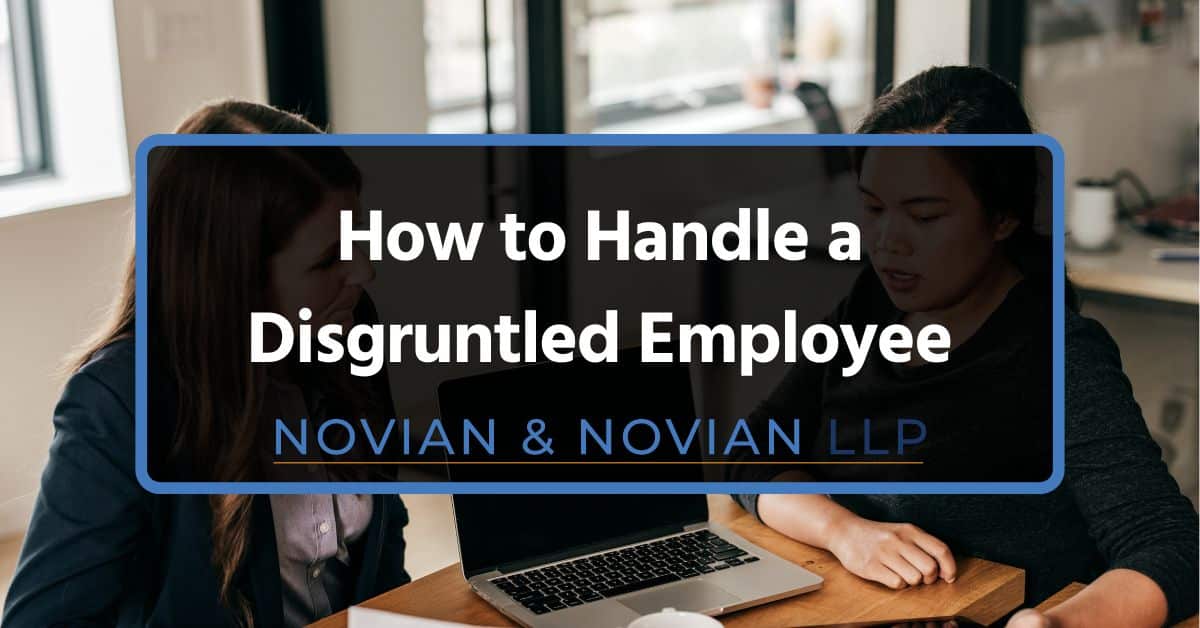
| June 24, 2024 | Employment Law
A disgruntled employee is someone who holds a grudge toward your organization. This grudge could lead to less motivation to do work, which further leads to reduced productivity. As an employer, you must actively engage in and resolve cases of disgruntled employees to improve workplace morale and productivity. If you ignore such situations, it can lead to serious consequences like sabotage and theft, legal action, and even violence or safety concerns.
Maintaining a positive work environment and effectively handling disgruntled employees are essential for any business. With over 30 years of experience, Novian & Novian specializes in compliance and legal representation for employers. Our experienced employer defense attorneys can help you navigate complex employment issues, ensuring your company remains compliant and protected. Schedule a free consultation with us today!
In this blog, we will shed more light on the issue of disgruntled employees and possible causes. We will also talk about how to handle a disgruntled employee and how to avoid possible situations.
What is a Disgruntled Employee?
A disgruntled employee is an individual who is unhappy or dissatisfied with their job or work environment. This discontent can stem from various sources, leading to a range of negative behaviors that can impact both their own productivity and the overall workplace atmosphere.
Typically, a dissatisfied employee may start spreading negativity or making derogatory remarks about the company or co-worker. However, the general signs you should look out for that could indicate a disgruntled employee include increased absenteeism, withdrawal, or becoming more confrontational. There would also be decreased productivity in the performance of the employee. Once you notice any of these signs, you need to take action immediately.
What causes a Disgruntled Employee?
One typical cause of disgruntled employees is personal issues. It could be that the employee is facing problems outside of work such as family or financial issues. This creates stress that spills over into the workplace.
Another cause of a disgruntled employee is work-related stress. The employee may have high workloads, unrealistic deadlines, or a negative working environment. This contributes to employee dissatisfaction.
Unresolved conflicts in the workplace could also be a cause of a disgruntled employee. Often, it is a case of ongoing disputes with co-workers or management that are not addressed effectively.
Additionally, a lack of recognition or advancement opportunities could also lead to unhappy employees. If your employee feels undervalued or sees no clear path for career growth, it leads to disengagement and frustration.
How to Handle a Disgruntled Employee
As an employer, you have the responsibility of taking charge and addressing cases of disgruntled employees. If you don’t, it could lead to severe consequences for both the employee and the organization. Therefore, you have to continuously strive to create a positive work culture where employees feel engaged and valued.
In worst-case scenarios, ignoring a disgruntled employee can lead to legal action against you as an employer. This can take a toll on the finances of the company as the cost of a defense settlement is typically around $75,000. However, not only would the company’s finances be diminished, but so would the company’s reputation and standing. Furthermore, unaddressed disgruntled behavior can result in a negative impact on co-workers, such as spreading negativity and potentially creating a hostile work environment.
To learn more about legal defense for employers when dealing with disgruntled employees, contact Novian & Novian.
Initial Steps to Take – Understand and Document
As an employer with a disgruntled team member, you have to assess the situation carefully and avoid making hasty judgments. It is important that you remain professional and calm in all interactions with the disgruntled employee.
Without sentiments, you should properly write up an employee by documenting conversations, behaviors, and incidents. This includes noting dates, times, and specific actions. It is necessary to have employee write-ups as they provide a written record that can be referred to in future reference, ensuring that both the employee and the employer are on the same page.
Typically, an employee write-up serves as the first step of disciplinary caution. If the issue between the employee and the organization goes unresolved and the employee decides to escalate the matter further, the employee write-up could be a vital part of your case evidence.
How to Approach the Issue
To approach the issue of a disgruntled attitude, you can start by scheduling a one-on-one meeting. This meeting should be held in a private setting such as a conference room or private office to ensure confidentiality. It is important to make sure that the employee feels safe and secure during the conversation.
During the conversation, allow the disgruntled employee to express their concerns by listening actively and letting the employee speak without interruptions. As they speak, show empathy and understanding by demonstrating genuine concern for their issues and validating their feelings.
Developing a Plan of Action
Now that you have heard from the disgruntled employee, the next step would be to develop an action plan to resolve this issue. To do this, you need to work with the employee to find solutions that address their concerns.
Every employer must develop a plan of action in the case of things going sour. While no one ideally hopes for things to go sour, it is always better to be prepared ahead of time just in case. This way, you get to protect your interest and that of the organization.
You can develop a plan of action by setting realistic and achievable goals. You can also offer resources like providing access to employee assistance programs, counseling, or additional training. Your plan of action should reinforce that the employee is an important part of the team and their contributions are appreciated.
Implementing the Plan
Even after putting your plans in action, you need to conduct regular check-ins with the disgruntled employee. These consistent follow-up meetings help to discuss improvements or ongoing issues so that there would be a faster resolution. Keep in mind that your plans as an employer should be flexible. This way, you can modify the action plan based on feedback and progress.
It is also important to recognize and celebrate positive changes in behavior and performance so that the employee feels a sense of care. Additionally, maintain open lines of communication to prevent future employee grievances.
The going of the strategies highlighted here in implementing the plan is to keep evidence of the employee’s concerns and attempt to reinvigorate the employee. They would all come together to foster the positive workplace you desire.
Handling Escalations with Employees
Addressing issues with a disgruntled employee can sometimes escalate to the point where formal warnings or disciplinary measures are necessary. It is important to handle these situations in a professional manner and be consistent with company policies to maintain a positive work environment and avoid potential legal repercussions.
The steps for formal warnings or disciplinary measures are:
- Initial Documentation: This is the first step for you as an employer where you need to document all instances of disgruntled behavior, noting dates, times, and specific actions. This creates a clear record that supports any further actions.
- Verbal Warning: It could get to the point where you need to communicate issues clearly with the employee and give a verbal warning. At this point, make sure the employee understands the consequences of continuing with the behavior. It is important that this be done as a private meeting in a conference room or private office.
- Written Warning: If the behavior continues, you need to issue a formal written warning. This should detail the unacceptable behavior, reference previous verbal warnings, and outline the expected changes and consequences for failing to improve.
- Suspension: In cases of severe or repeated issues, a temporary suspension might be necessary. This gives the employee time to reflect on their behavior and consider the changes needed to avoid termination.
- Performance Improvement Plan (PIP): As the employer, you will need to implement a performance improvement plan (PIP) that sets clear, measurable goals and provides the employee with the resources needed to improve. You should also have regular check-ins with the employee to monitor progress and provide feedback.
Termination as a Last Resort
When all other measures have failed, termination may be the only option. It is best to handle this process legally and professionally to avoid legal action and maintain a respectful workplace culture.
The process of termination starts by reviewing company policies to ensure that the termination process aligns and is documented properly. Then, compile all records of warnings, meetings, and attempts to address the issues. This documentation is crucial for defending against wrongful termination claims. Before proceeding with termination, you should consult with legal counsel or HR to ensure compliance with employment laws, including the wrongful termination statute of limitations.
The termination meeting should be held in a private setting. During this meeting, clearly communicate the reasons for termination and ensure the conversation remains professional. You should also provide information about severance, benefits, and any outplacement services. This helps maintain a respectful tone and can ease the transition for the employee. Importantly, keep detailed records of the termination process, including the meeting, reasons for termination, and any documents provided to the employee.
As an employer, you must be conscious about taking all these necessary steps when dealing with employee terminations as potentially violent situations can arise from mishandling the issue. When an employee gets laid off inappropriately a lot of negativity can sprout, resulting in threats and violence being directed at you the employer, or other employees. According to the Violence Project, a research center dedicated to reducing violence through research, of the 53 mass workplace shootings that occurred between 1966 and 2021, 70% of them were due to employment issues, such as termination.
At Novian & Novain, we understand the complexities and sensitivities involved in handling disgruntled employees and potential terminations. Our experienced legal team can help you navigate these challenges and ensure compliance with labor laws to avoid legal action. Our goal is to help you maintain a positive and legally sound workplace. Contact us today for a free consultation.
Preventing Future Issues with Employees
To maintain a positive work environment and prevent future issues with disgruntled employees, you will need to implement proactive strategies. These will foster a supportive workplace culture, and make employees feel engaged, valued, and motivated.
Some proactive strategies include:
- Foster a culture of open communication and feedback: As an employer, you should encourage employees to voice their concerns, ideas, and feedback without fear of retribution. This can be achieved through regular team meetings, suggestion boxes, and anonymous surveys. You should also train managers and team leaders to listen actively to employee grievances. This helps in identifying and addressing issues before they escalate.
- Recognize and reward employee achievements: It is important for employers to acknowledge and celebrate employee achievements and milestones. This can be through awards, shout-outs during meetings, or company-wide announcements. Recognition boosts morale and encourages a positive work environment.
- Provide regular training on conflict resolution and stress management: You have a duty as an employer to equip employees with the skills to handle conflicts constructively. Regular workshops on conflict resolution can help in reducing workplace tensions and promoting harmony. You should also offer training sessions on stress management techniques. This includes mindfulness practices, time management strategies, and providing access to employee assistance programs.
- Encourage career development and growth opportunities: Employers should offer opportunities for continuous learning and development to employees. This can include training sessions, workshops, and access to online courses.
Need to know how to Handle a Disgruntled Employee?
Handling a disgruntled employee requires a structured and empathetic approach. This includes active listening, acknowledging and documenting, investigating thoroughly, developing an action plan, and implementing and monitoring.
Addressing employee grievances promptly can make all the difference in preventing a negative work environment and ensuring a productive workplace. Typically, unresolved issues can lead to disengaged employees, spreading negativity, and even legal action. By taking proactive steps, you foster a supportive work environment where employees feel engaged, valued, and motivated.
If it gets to the point where you have to respond to a legal claim, ensure that you work with a professional attorney. The work of an employer defense attorney is to ensure that the best interest of the employer is put forward.
For businesses that need assistance with employee relations or ensuring compliance with labor laws, Novian & Novian offers expert legal support. We run one of the best Los Angeles employer defense practices, and our business attorneys specialize in employer defense and can help you navigate complex employment issues to maintain a legally sound workplace. Contact us now for a free consultation.
Contact Us
Have questions about this post? Novian & Novian is a full service law firm in Los Angeles with clients that span the country. Contact us today for a free consultation.
Contact Us
Have questions about this post? Novian & Novian is a full service law firm in Los Angeles with clients that span the country. Contact us today for a free consultation.





